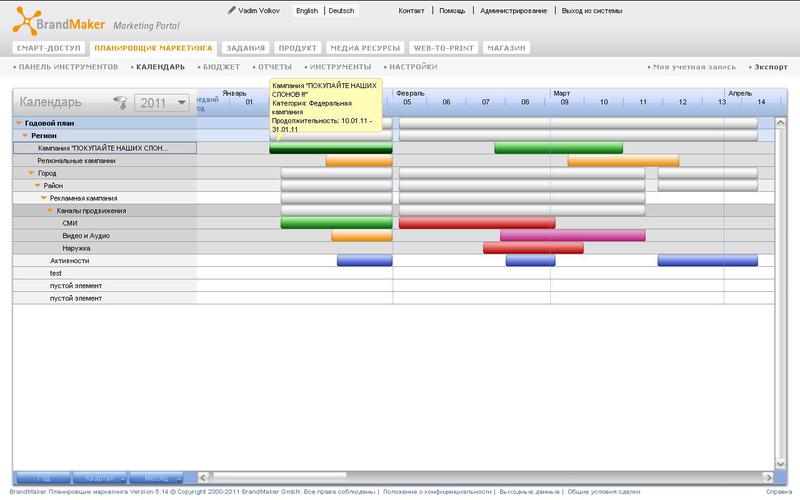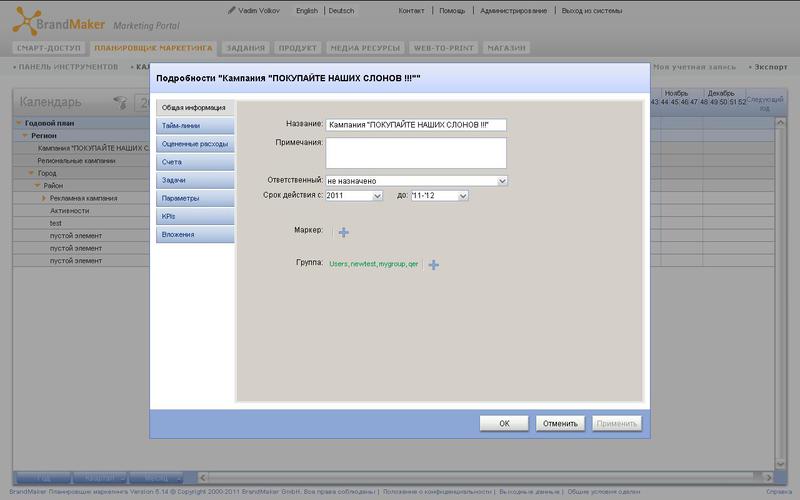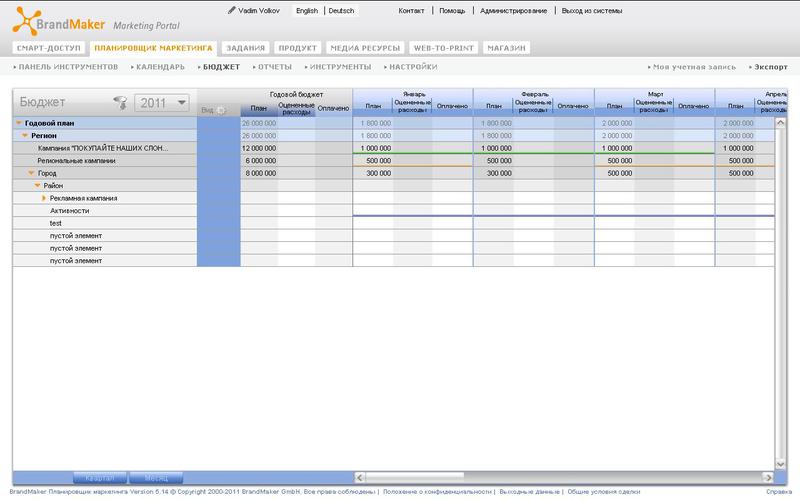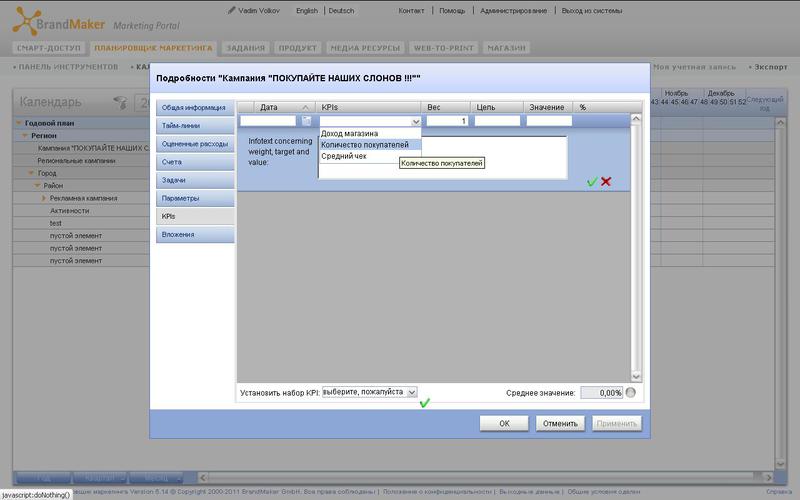Marketing Planning Module: A Strategic Approach
"The more time we spend on planning, the more it becomes."
Common phrase and, judging by the craze for time management, there is a fair amount of truth in it. Well, and since demand gives rise to supply, all sorts of task managers and planners are no longer riveting, perhaps, just lazy. There are a lot of options - and paid, and free, and corporate, and personal, and working on mobile phones, and made in the format of web applications ...
In this situation, talking about the next planner, you risk not only getting lost in the crowd, but also getting a legitimate question “why?”. Why would anyone need exactly your solution?
')
But, nevertheless, BrandMaker does have its own Scheduler, and this module is one of the most popular and sought after European customers of the company. Why? Let's try to figure it out. We present to your attention a brief overview of the module.

First of all, it should be noted that, like the whole BrandMaker system as a whole, the Marketing Planning module is a highly specialized solution, and therefore performs some functions better and more simply simply because it is “tailored” specifically for them. Therefore, the main advantages of the module will be more correctly called simply features, or key parameters.
So, the BrandMaker scheduler has the following features:
1. This is a web application - with all the consequences, as they say. The most important thing here is that the geographical position of the company's branches becomes unimportant. At the request of the client, the scheduler can be accessed via the Internet and / or through closed corporate networks.
2. This application is for strategic planning - at the level of the whole company, dealer network, distribution network, etc. The level of detail of the plan here, if desired, can be set up to specific tasks for specific performers, but the best option is such a division of tasks, at which managers are responsible for the level of branch managers or heads of marketing departments.
Target users of the system are the same managers, heads of marketing departments in branches or dealers. The planner allows them to see the overall picture of the strategic planning, as well as their tasks within the framework of this plan. Accordingly, the task of operational and complete cascading of the plans of the central office into the branches is facilitated by an order of magnitude.
This is how a similar plan might look like (attention: screenshots are not based on real events).

Here we see the “Calendar” tab, the main element of which is a table in which the contents of the plan are displayed in the row headers - for example, a list of advertising campaigns in all areas. Columns are time spans. The time format can be scaled. In this case, the 1st quarter of the year is displayed in increments of the timeline of 1 week.
The planned activities themselves are displayed in time lines of different colors. When you hover over the timeline, a window pops up with a hint. A separate window opens in the context menu for detailed settings of the activity parameters:

In this case, the Timelines tab allows you to set and edit campaign dates; “Estimated expenses” and “Accounts” are tools for budgeting; “Tasks” - allows you to create tasks within the selected campaign (either in the scheduler itself, or in the “Task management” module integrated with it, which we will talk about another time), “Parameters” - include the choice of suppliers, partners, products and other significant parameters of the system - their set depends on the specifics of the client. In the KPI tab, key campaign performance indicators are set, and finally, various files can be attached in the Attachments.
Some of the tabs tell a little more. So:
3. Planning is combined with budgeting. One of the parameters set for time lines and subtasks is the budget. It is possible, firstly, to assess the budget layout at the planning stage, and secondly, to track the budget development over time, since when the tasks are “closed”, the scheduler also takes into account the money spent.
Tools for displaying costs are located in the settings window for each project:

Here you can specify the counterparties, the purpose of the payment, the manager, in a separate tab to attach a specific account.
The overall picture of budgeting is visible in a special section:

For each cost, there are three columns here - a plan (here the amounts here can be set without reference to specific accounts and constitute a “ceiling” of costs for this direction, for example), “Estimated expenses” - data provided already immediately after the selection of suppliers. And, finally, “Paid” - to reflect whether the budget is mastered.
4. Planning is combined with KPI control. For each task within the plan, you can set one or more key performance parameters - qualitative or quantitative, and set their planned values. When “closing” a task, the actual KPI values are indicated and, accordingly, the overall performance of the task is automatically assessed - for example, an advertising campaign as a whole or by section for individual regions / branches.

In conclusion, I want to note that the module is equipped with its own reporting tools. Customization of the content and design of reports is made on the basis of customer needs This may be a budget report, KPI report, deadlines, etc. with the ability to set any period for reporting and automatically generate charts, graphs, etc.
In addition, an important tool is a tab in which each user can see the part of the general plan that concerns him personally - that is, all tasks for which the user is assigned a responsibility are displayed in one window:

Thanks for attention! Ready to answer any of your questions. It would be interesting to learn about examples of solutions already used in Russia that are similar in parameters to ours.
Common phrase and, judging by the craze for time management, there is a fair amount of truth in it. Well, and since demand gives rise to supply, all sorts of task managers and planners are no longer riveting, perhaps, just lazy. There are a lot of options - and paid, and free, and corporate, and personal, and working on mobile phones, and made in the format of web applications ...
In this situation, talking about the next planner, you risk not only getting lost in the crowd, but also getting a legitimate question “why?”. Why would anyone need exactly your solution?
')
But, nevertheless, BrandMaker does have its own Scheduler, and this module is one of the most popular and sought after European customers of the company. Why? Let's try to figure it out. We present to your attention a brief overview of the module.

First of all, it should be noted that, like the whole BrandMaker system as a whole, the Marketing Planning module is a highly specialized solution, and therefore performs some functions better and more simply simply because it is “tailored” specifically for them. Therefore, the main advantages of the module will be more correctly called simply features, or key parameters.
So, the BrandMaker scheduler has the following features:
1. This is a web application - with all the consequences, as they say. The most important thing here is that the geographical position of the company's branches becomes unimportant. At the request of the client, the scheduler can be accessed via the Internet and / or through closed corporate networks.
2. This application is for strategic planning - at the level of the whole company, dealer network, distribution network, etc. The level of detail of the plan here, if desired, can be set up to specific tasks for specific performers, but the best option is such a division of tasks, at which managers are responsible for the level of branch managers or heads of marketing departments.
Target users of the system are the same managers, heads of marketing departments in branches or dealers. The planner allows them to see the overall picture of the strategic planning, as well as their tasks within the framework of this plan. Accordingly, the task of operational and complete cascading of the plans of the central office into the branches is facilitated by an order of magnitude.
This is how a similar plan might look like (attention: screenshots are not based on real events).

Here we see the “Calendar” tab, the main element of which is a table in which the contents of the plan are displayed in the row headers - for example, a list of advertising campaigns in all areas. Columns are time spans. The time format can be scaled. In this case, the 1st quarter of the year is displayed in increments of the timeline of 1 week.
The planned activities themselves are displayed in time lines of different colors. When you hover over the timeline, a window pops up with a hint. A separate window opens in the context menu for detailed settings of the activity parameters:

In this case, the Timelines tab allows you to set and edit campaign dates; “Estimated expenses” and “Accounts” are tools for budgeting; “Tasks” - allows you to create tasks within the selected campaign (either in the scheduler itself, or in the “Task management” module integrated with it, which we will talk about another time), “Parameters” - include the choice of suppliers, partners, products and other significant parameters of the system - their set depends on the specifics of the client. In the KPI tab, key campaign performance indicators are set, and finally, various files can be attached in the Attachments.
Some of the tabs tell a little more. So:
3. Planning is combined with budgeting. One of the parameters set for time lines and subtasks is the budget. It is possible, firstly, to assess the budget layout at the planning stage, and secondly, to track the budget development over time, since when the tasks are “closed”, the scheduler also takes into account the money spent.
Tools for displaying costs are located in the settings window for each project:

Here you can specify the counterparties, the purpose of the payment, the manager, in a separate tab to attach a specific account.
The overall picture of budgeting is visible in a special section:

For each cost, there are three columns here - a plan (here the amounts here can be set without reference to specific accounts and constitute a “ceiling” of costs for this direction, for example), “Estimated expenses” - data provided already immediately after the selection of suppliers. And, finally, “Paid” - to reflect whether the budget is mastered.
4. Planning is combined with KPI control. For each task within the plan, you can set one or more key performance parameters - qualitative or quantitative, and set their planned values. When “closing” a task, the actual KPI values are indicated and, accordingly, the overall performance of the task is automatically assessed - for example, an advertising campaign as a whole or by section for individual regions / branches.

In conclusion, I want to note that the module is equipped with its own reporting tools. Customization of the content and design of reports is made on the basis of customer needs This may be a budget report, KPI report, deadlines, etc. with the ability to set any period for reporting and automatically generate charts, graphs, etc.
In addition, an important tool is a tab in which each user can see the part of the general plan that concerns him personally - that is, all tasks for which the user is assigned a responsibility are displayed in one window:

Thanks for attention! Ready to answer any of your questions. It would be interesting to learn about examples of solutions already used in Russia that are similar in parameters to ours.
Source: https://habr.com/ru/post/132343/
All Articles